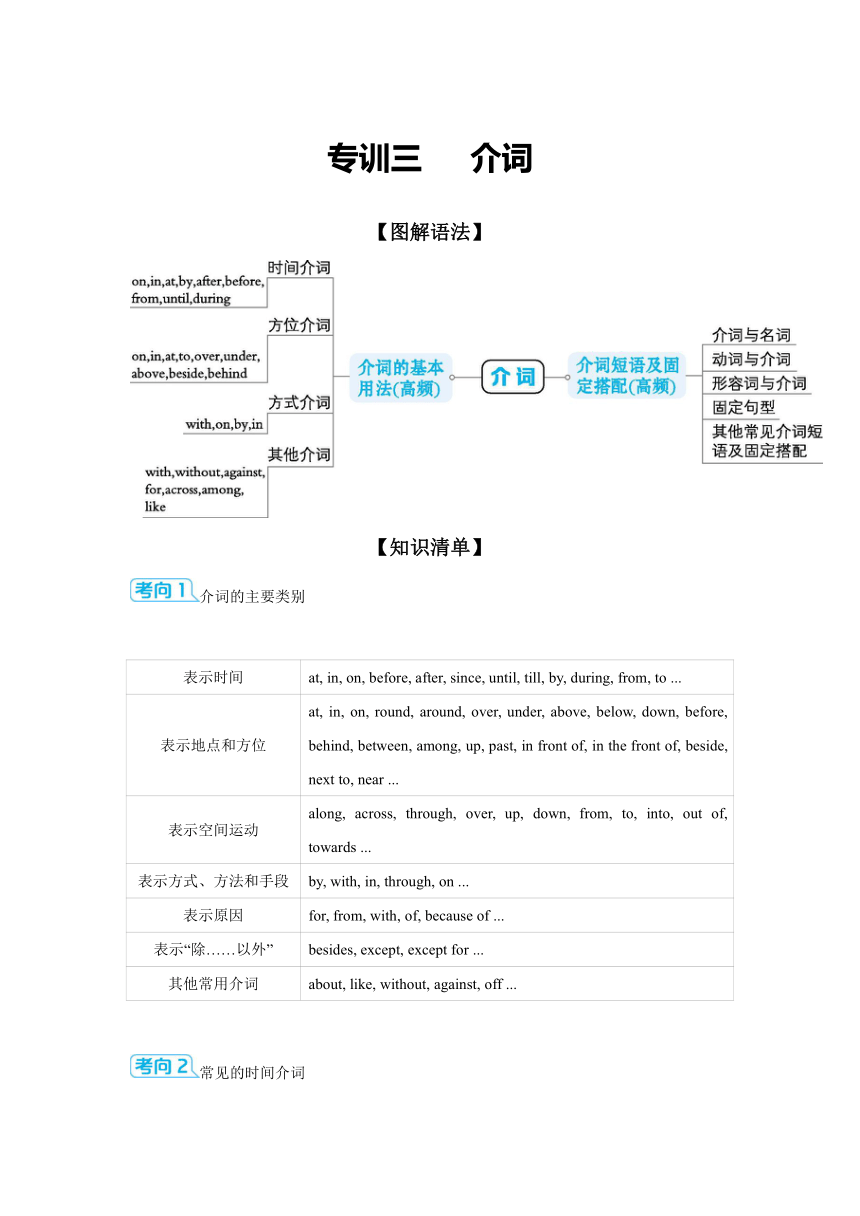
专训三 介词 【图解语法】 【知识清单】 介词的主要类别 表示时间 at, in, on, before, after, since, until, till, by, during, from, to ... 表示地点和方位 at, in, on, round, around, over, under, above, below, down, before, behind, between, among, up, past, in front of, in the front of, beside, next to, near ... 表示空间运动 along, across, through, over, up, down, from, to, into, out of, towards ... 表示方式、方法和手段 by, with, in, through, on ... 表示原因 for, from, with, of, because of ... 表示“除……以外” besides, except, except for ... 其他常用介词 about, like, without, against, off ... 常见的时间介词 1.at, in, on at 侧重于表示时间点,用于时刻前。表示“在某一时刻;在几点几分”,也可表示“在……(点)” at four (o'clock) 在四点 at a quarter to nine 8:45 常用于固定搭配的短语中 at noon 在中午;at night 在夜晚;at weekends 在周末;at breakfast/lunch/supper 在吃早饭/午饭/晚饭时;at this time of day 在每天的这个时候;at the moment此刻,现在 in 强调某个时间段,常用于上午、下午、晚上或世纪、年、月、季节等之前。in+一段时间,一般用于一般将来时 in the morning/afternoon/evening 在上午/下午/晚上; in the day 在白天 in July在七月;in 2012 在2012年;in March在三月;in spring/summer/autumn/winter 在春天/夏天/秋天/冬天; in the 21st century 在21世纪; in ten years十年后 on 表示具体的某一天,后接具体的日期,表示某一天的上午、下午、晚上,或用于有形容词修饰的某一天前等 on Sunday 在星期天;on weekdays 在工作日;on Friday morning/afternoon/evening 在星期五早上、上午/下午/晚上;on the afternoon of March 5th 在三月五日下午;on a cold winter evening 在一个寒冷冬天的晚上; on September 28th 在九月二十八日 用于公共节假日前 on New Year's Day 在元旦;on Children's Day 在儿童节 2.for, since for+时间段 表示动作的延续。主句常用现在完成时、过去完成时或一般过去时 I have had (不用have bought) the car for three years.我买这辆车已有三年了。 I have been there for two weeks. 我在那儿已经待了两个星期了。 since+时间点 意为“从……起;自……以来”,表示动作从过去某个时刻持续到了现在(说话时刻)或过去某一时刻。主句常用现在完成时或过去完成时 He has taught English since he came here in 1990. 他自从1990年就来这教英语了。 A lot of new things have happened since three years ago. (不用since three years)自从三年前以来,许多新鲜事发生了。 He had waited for the police since he called 110 ten minutes earlier.他自从10分钟前报警,就一直在等待警察。 常见的地点介词 表示地点的介词有in、 on、 at、 to等,对其考查侧重于at、 on、 in的区别。at着重把所处的位置看作是某一个点,范围不明确,意为“在……内;在……上”,一般与较小的地方连用。in表示在某一区域或某一个立体的地方内,意为“在……(里)”,一般与较大的地方连用。on表示在一条线或一个平面上,意为“在……上”,如on the ground, on the wall, on the farm。 常见的方位介词 1.方位介词辨析图示 2.方位介词in、 on与 to 在表示方位时,in表示在某一地区内的某个方位(属于该范围);表示两地区“接壤”时,用介词on;表示“在某一范围之外(两地没有挨着)”时,用介词to。 常用的方式介词in、 by与with in 表示“用某种语言”,也可表示“用工具、材料”等 by “by+交通工具名词”表示搭乘或借助某种交通工具,如:by bus/bike/plane/...,可与“take ... ...
~~ 您好,已阅读到文档的结尾了 ~~